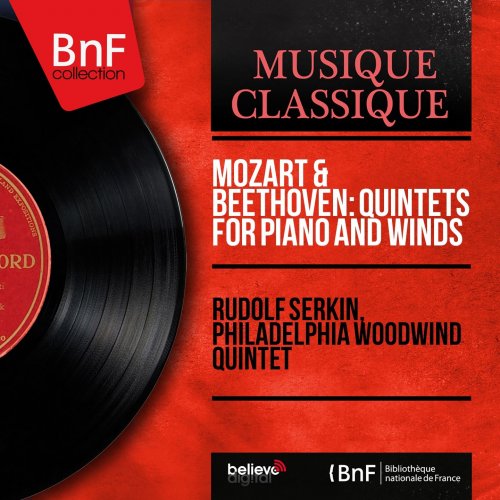
Rudolf Serkin, Philadelphia Woodwind Quintet - Mozart & Beethoven: Quintets for Piano and Winds (2005) Hi-Res
BAND/ARTIST: Rudolf Serkin, Philadelphia Woodwind Quintet
- Title: Mozart & Beethoven: Quintets for Piano and Winds
- Year Of Release: 2005
- Label: BNF Collection
- Genre: Classical
- Quality: FLAC 24bit-96kHz / FLAC (tracks)
- Total Time: 50:11
- Total Size: 495 / 128 Mb
- WebSite: Album Preview
Tracklist:
1. Quintet for Piano and Winds in E-Flat Major, K. 452: I. Largo - Allegro moderato 10:40
2. Quintet for Piano and Winds in E-Flat Major, K. 452: II. Larghetto 09:26
3. Quintet for Piano and Winds in E-Flat Major, K. 452: III. Allegretto 05:33
4. Quintet for Piano and Winds in E-Flat Major, Op. 16: I. Grave - Allegro ma non troppo 10:23
5. Quintet for Piano and Winds in E-Flat Major, Op. 16: II. Andante cantabile 09:07
6. Quintet for Piano and Winds in E-Flat Major, Op. 16: III. Rondo. Allegro ma non troppo 05:35
Performers:
Rudolf Serkin (piano)
Philadelphia Woodwind Quintet
1. Quintet for Piano and Winds in E-Flat Major, K. 452: I. Largo - Allegro moderato 10:40
2. Quintet for Piano and Winds in E-Flat Major, K. 452: II. Larghetto 09:26
3. Quintet for Piano and Winds in E-Flat Major, K. 452: III. Allegretto 05:33
4. Quintet for Piano and Winds in E-Flat Major, Op. 16: I. Grave - Allegro ma non troppo 10:23
5. Quintet for Piano and Winds in E-Flat Major, Op. 16: II. Andante cantabile 09:07
6. Quintet for Piano and Winds in E-Flat Major, Op. 16: III. Rondo. Allegro ma non troppo 05:35
Performers:
Rudolf Serkin (piano)
Philadelphia Woodwind Quintet
Professional chamber wind ensembles are common nowadays, but in Mozart's and Beethoven's time, such groups as these composers required were most often ad hoc gatherings of friends or local musicians. Even as late as 1953, when pianist Rudolf Serkin recorded Mozart's Quintet, K. 452, and Beethoven's Quintet, Op. 16, for Columbia, he had to call on wind players from the Philadelphia Orchestra to fill the oboe, clarinet, bassoon, and horn parts. As a result of this, or perhaps because of insufficient preparation, there are problems of balance and blending in these recordings that practiced wind groups would avoid, yet somehow went unnoticed by Serkin and company. On the whole, John de Lancie's oboe and Sol Schoenbach's bassoon sound even and controlled, well-matched to Serkin's restrained playing; but Anthony Gigliotti's hooting clarinet and Mason Jones' robust horn stray into louder dynamics, and fat bulges in the ensemble's textures frequently occur. Due to the limitations of the mono reproduction, the group's tutti almost overwhelm the single microphone, and the sound is a little obnoxious in fortissimo passages. These recordings have been cleaned of tape hiss but still sound boxy and annoyingly boosted in the ADD transfer. This CD may be judged as an interesting historical document, but it may not appeal to listeners who demand polished playing or clean digital sound with natural resonance.
Classical | FLAC / APE | HD & Vinyl
As a ISRA.CLOUD's PREMIUM member you will have the following benefits:
- Unlimited high speed downloads
- Download directly without waiting time
- Unlimited parallel downloads
- Support for download accelerators
- No advertising
- Resume broken downloads


